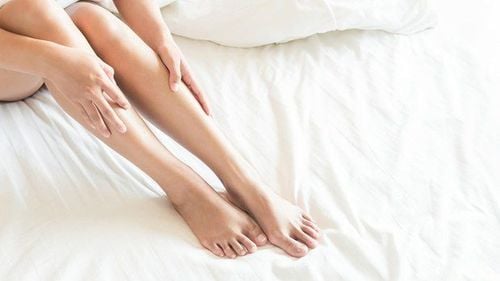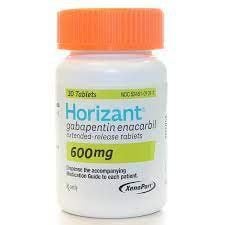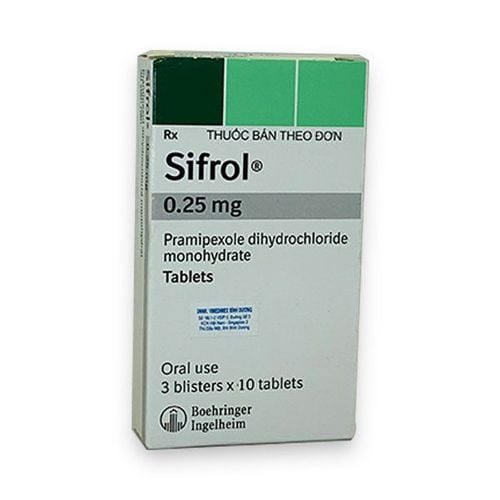This is an automatically translated article.
Restless legs syndrome, also known as Willis-Ekbom disease, can occur at any age and usually worsens as the person gets older. It can disrupt sleep and interfere with daily activities.
1. What is Restless Legs Syndrome?
Restless Leg Syndrome (RLS) causes discomfort or discomfort in the legs and an inability to resist the urge to move. Symptoms usually occur in the late afternoon or evening and are often most severe at night when the person is resting, such as sitting or lying in bed.
RLS can also occur with inactivity and sitting for long periods of time (for example, when traveling by plane or watching a movie). Because symptoms can increase in severity and become worse at night, people with this syndrome may have trouble falling or staying asleep after being awakened in the middle of the night. Moving the legs or walking usually relieves the discomfort, but this sensation often recurs after the movement stops.
RLS is classified as a sleep disorder because symptoms are triggered by resting and trying to sleep, and is also a movement disorder, because people are forced to move their legs to relieve symptoms. However, RLS is primarily classified as a neurosensory disorder with symptoms generated by the brain itself.
Restless legs syndrome is one of a number of disorders that can cause exhaustion and daytime sleepiness, which can drastically affect mood, concentration, work performance, study, and relationships. personal. Many people with RLS report being unable to concentrate, have impaired memory, or fail to complete daily tasks.
Untreated moderate to severe RLS can lead to an approximately 20% decrease in work productivity and may contribute to depression and anxiety. It can also make it difficult to walk.
It is estimated that up to 7-10% of the US population may have RLS. RLS occurs in both men and women, although women are more likely to develop it than men. This syndrome can begin at any age. Many people are severely affected in middle age or older, and symptoms often become more frequent and longer lasting with age.
More than 80% of people with RLS also experience cyclic limb movement during sleep (PLMS). PLMS is characterized by involuntary twitching movements of the legs (and sometimes arms) during sleep, usually occurring every 15 to 40 seconds, sometimes throughout the night.
Fortunately, most cases of RLS can be treated with non-drug therapies and, if needed, medication.
2. Typical signs and symptoms of restless legs syndrome
People with restless legs syndrome will feel an irresistible need to move, accompanied by unpleasant sensations in the lower extremities, unlike the normal sensations experienced by people without the disorder. via. The sensations in their legs are often difficult to define but can be described as stinging, itching, prickling, or crawling. These sensations rarely affect the arms and rarely the chest or head. Although sensations can occur on only one side of the body, they usually affect both legs or can alternate between the sides. The sensations range in severity from discomfort to pain.
Because moving the legs (or other affected parts of the body) reduces discomfort, people with RLS often maintain their legs in motion to minimize or prevent that sensation. They can run quickly across the floor, constantly moving their legs while sitting, and turning when lying in bed.
A typical sign of restless legs syndrome is symptoms that get worse at night and a period of no noticeable symptoms in the early morning, allowing you to have a more refreshing sleep at that time. there. Some people with RLS have trouble falling asleep and staying asleep. Symptoms get worse if their sleep is further impaired by work or daily activities.
RLS symptoms can vary from day to day, in severity and frequency, and from person to person. In moderate cases, symptoms occur only once or twice a week but often result in a markedly delayed onset of sleep, accompanied by disruption of daytime function. In severe cases of RLS, symptoms occur more than twice a week and lead to severely disrupted sleep and impaired daily functioning.
Symptoms in patients with restless legs syndrome can sometimes go into remission - spontaneous improvement over a period of weeks or months before symptoms reappear - often in the early stages of the disorder chaos. In general, however, symptoms become more severe over time.
In people with RLS with another medical condition, symptoms get worse quickly. In contrast, people with RLS and no other comorbidities show a very slow progression of the disorder, especially if RLS has an early onset.

Hội chứng chân không yên là một trong số các rối loạn có thể gây kiệt sức và buồn ngủ ban ngày
3. What causes restless legs syndrome?
In most cases, the cause of restless legs syndrome is not clear (known as primary RLS). However, RLS has a genetic element and can be found in families with symptom onset before age 40. Specific gene variants are associated with RLS. Evidence indicates that low levels of iron in the brain may also be responsible for RLS.
In addition, there is evidence that RLS is associated with dysfunction in one of the parts of the brain that control movement (called the basal ganglia). The basal ganglia use the brain chemical dopamine. Dopamine is needed to produce smooth, purposeful muscle movement and activity. Disruption of these pathways often leads to unintentional movements. People with Parkinson's disease, another disorder of the basal ganglia dopamine pathways, have a higher risk of developing RLS.
RLS also seems to be associated with or associated with the following:
End-stage renal disease and hemodialysis ; Iron deficiency; Certain medications can worsen RLS symptoms, such as anti-nausea medications (eg, prochlorperazine or metoclopramide), antipsychotics (eg, haloperidol or a phenothiazine derivative), antidepressants increases serotonin (eg, fluoxetine or sertraline), and some cold and allergy medicines that contain older antihistamines (eg, diphenhydramine); Alcohol, nicotine and caffeine use; Pregnancy, especially in the last 3 months; in most cases, symptoms usually disappear within 4 weeks of giving birth; Neuropathy (nerve damage). Sleep deprivation and other sleep conditions such as sleep apnea may also worsen or trigger symptoms in some patients. Reducing or completely eliminating these factors can relieve those symptoms.
4. Prognosis in people with restless legs syndrome
Restless legs syndrome is a lifelong condition with no cure. However, current therapies can control the disorder, minimize symptoms, and increase the time it takes to fall asleep. Symptoms may gradually worsen with age, and decline may be slightly faster for people with comorbidities.
A diagnosis of RLS cannot indicate the onset of another neurological disease, such as Parkinson's disease. In addition, some patients experience remission — periods in which symptoms decrease or disappear for days, weeks, months, or years — although they often eventually reappear. If RLS symptoms are mild, do not cause significant daytime discomfort, or do not affect your ability to fall asleep, the condition does not require treatment.
5. Restless legs syndrome in children
Children can experience tingling and pulling sensations in their legs just like adults with restless legs syndrome. But babies may have trouble describing it. Children may call it a "scary" feeling.
Children with RLS also have an excessive need to move their legs and often have more symptoms during the day than adults.
RLS can interfere with sleep, affecting every aspect of life. A child with RLS is often inattentive, irritable, or restless. Adults may mistake them for being disruptive or hyperactive. Diagnosing and treating RLS can help address these problems and improve learning in children.
Restless legs syndrome in children under 12 years of age have the same signs and symptoms as adults:
Feeling of an urge to move; At night the symptoms get worse; Symptoms are triggered when the child tries to relax or sleep; Symptoms are relieved when the child moves; Children with RLS should avoid caffeine and develop good bedtime habits.
If necessary, drugs that affect dopamine, benzodiazepines and anticonvulsants can be prescribed by your doctor.

Hội chứng chân không yên là một tình trạng kéo dài suốt đời mà không có cách chữa trị
6. Dietary recommendations in people with restless legs syndrome
There aren't any specific dietary guidelines for people with restless legs syndrome. But it is better to review our diet to make sure that the body is getting the right amount of vitamins and nutrients it needs. Try to cut back on processed foods that are high in calories but have little or no nutritional value.
Some people with symptoms of RLS are deficient in specific vitamins and minerals. If that's the case, you can make some changes to your diet or take a supplement. It all depends on what your health test results are.
In case of iron deficiency, try adding more of the following iron-rich foods to your diet:
Dark green leafy vegetables; Peas; Dried fruits; Red meat and pork; Poultry and seafood; Iron-fortified foods such as certain cereals, pastas, and breads. Vitamin C helps the body absorb iron, so we can also combine iron-rich foods with the following sources of vitamin C:
Citrus juices; Grapefruit, orange, tangerine, strawberry, kiwi, melon; Tomato, chili; Broccoli, green leafy vegetables. Caffeine is a controversial substance. It can cause symptoms of RLS in some patients, but is actually beneficial for others. We can try a little bit of caffeine to see how it affects symptoms.
Alcohol can make RLS worse, along with alcohol disrupting sleep. Therefore, alcohol should be avoided, especially in the evening.
In case the signs of restless legs interfere with life too much, the patient needs to find a reputable hospital for examination and specific treatment measures. Currently, Vinmec International General Hospital is one of the leading prestigious hospitals in the country, trusted by a large number of patients for medical examination and treatment. Not only the physical system, modern equipment: 6 ultrasound rooms, 4 DR X-ray rooms (1 full-axis machine, 1 light machine, 1 general machine and 1 mammography machine) , 2 DR portable X-ray machines, 2 multi-row CT scanner rooms (1 128 rows and 1 16 arrays), 2 Magnetic resonance imaging rooms (1 3 Tesla and 1 1.5 Tesla), 1 room for 2 levels of interventional angiography and 1 room to measure bone mineral density.... Vinmec is also the place to gather a team of experienced doctors and nurses who will greatly assist in diagnosis and detection. early signs of abnormality in the patient's body. In particular, with a space designed according to 5-star hotel standards, Vinmec ensures to bring the patient the most comfort, friendliness and peace of mind.
Please dial HOTLINE for more information or register for an appointment HERE. Download MyVinmec app to make appointments faster and to manage your bookings easily.
References: ninds.nih.gov, healthline.com












